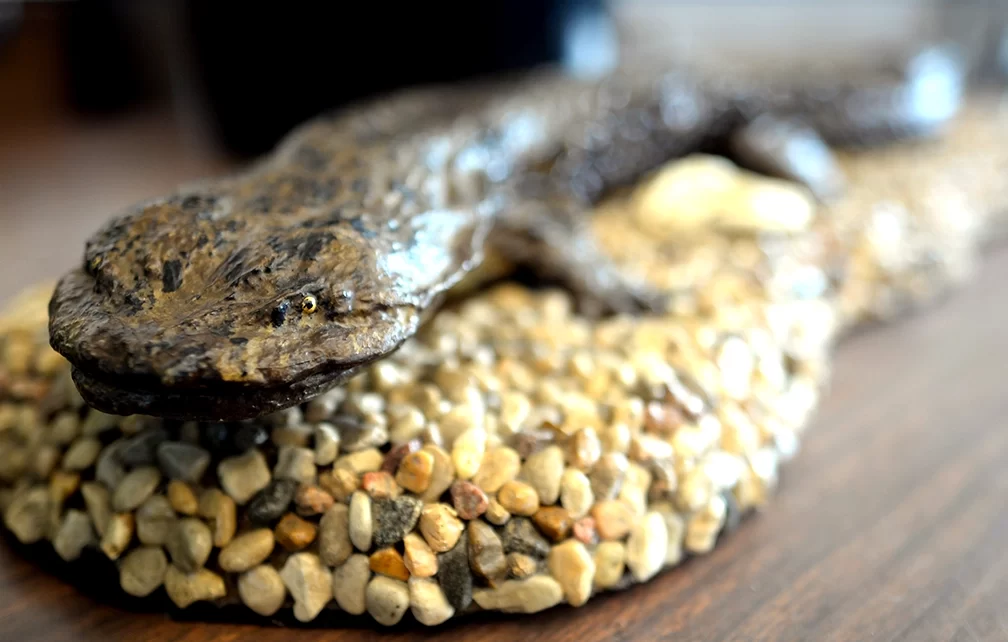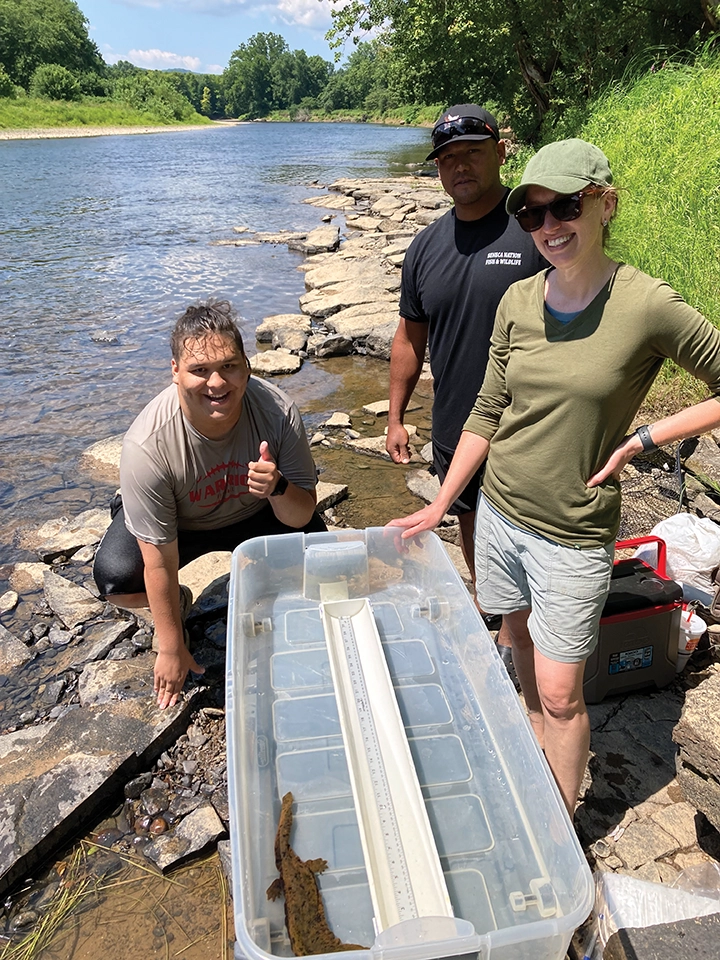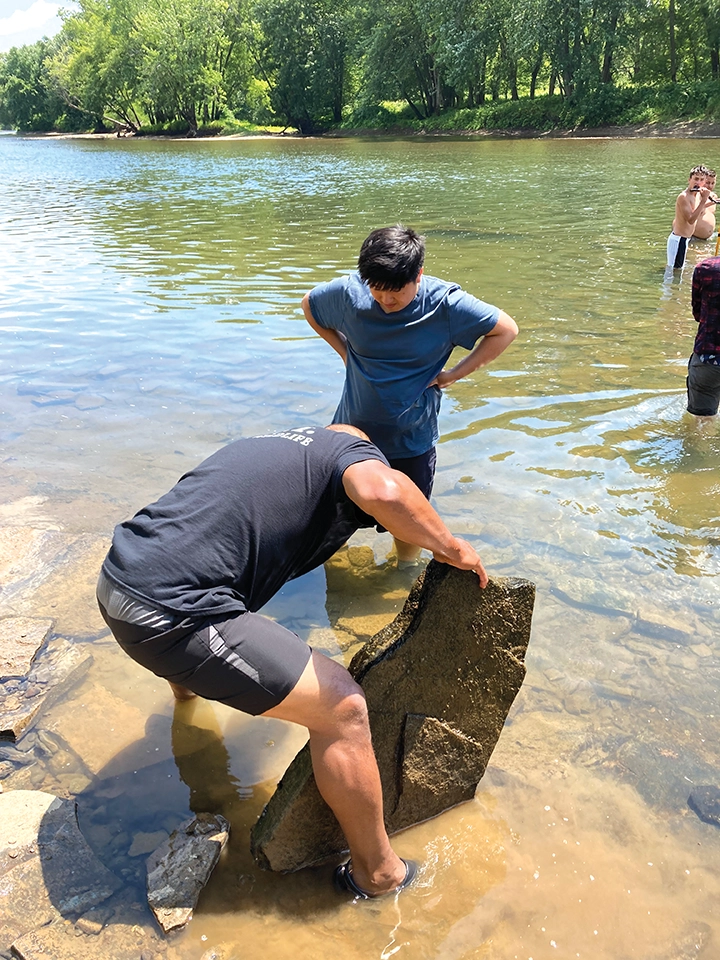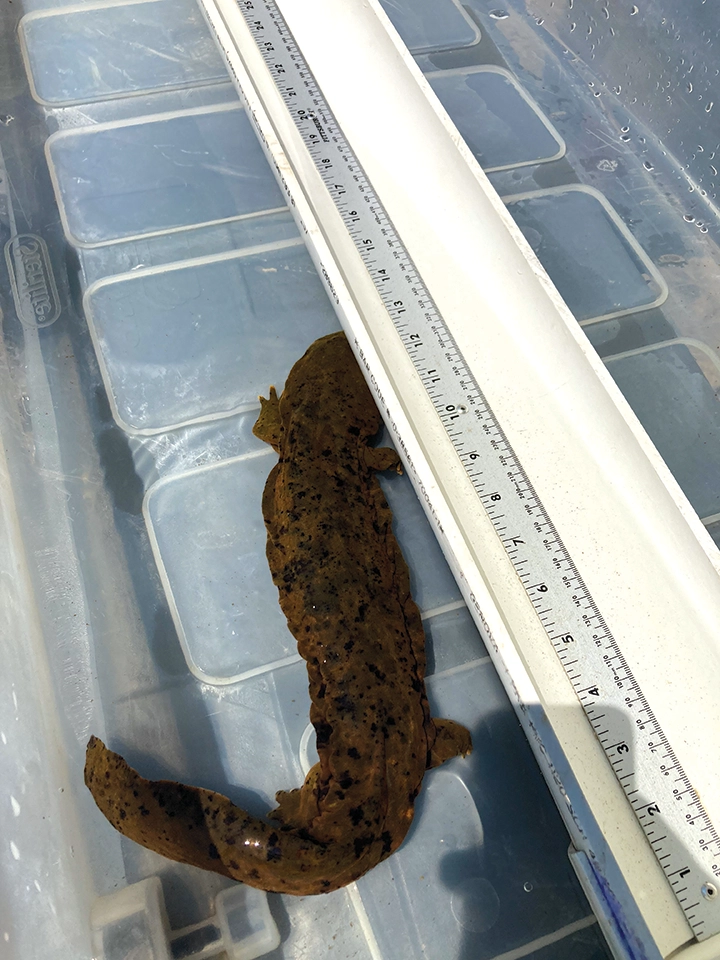Since 2009, the Seneca Nation Fish and Wildlife Department has made vast efforts to study, repopulate and protect hellbenders in the Allegheny River aka Ohi:yo’ and reservoir that flows through New York to Pennsylvania. Hellbenders are native to Ohi:yo’ and home to the first known sighting at Wolfe’s Run prior to the Kinzua Dam construction. Over the years, dam construction, erosion, water quality, environmental factors, bridge and home deconstruction lead to the hellbender population to decrease and become scarce within our ecosystem, another affect from the construction of the Kinzua Dam in 1964.
Hellbenders, the largest salamanders found on Turtle Island, are found solely in the Ohi:yo’ and Susquehanna Rivers and prefer unpolluted water with high oxygen levels and a fast current. These amphibians usually stick to their dark habitat under rocks until mating season and meal times. They are a full part of their ecosystem, serving as prey for fish and birds until they reach maturity and become a predator, feeding on crayfish, fish, insects and frogs. Their wide mouth allows them to consume prey double their size. Hellbenders have loose slimy skin and their gills disappear after maturity. Their lungs are used for floating rather than breathing and their tail is used to propel them through the water. They have short legs with four toes on the front legs and five on its back limbs. Their tail is shaped like a paddle, these salamanders use pads on their toes instead to grip rocks and walk up and down streams instead of swimming. They hardly ever leave the water as they are perfectly adapted to the cool swift waters of Ohi:yo’.
Will Miller, Director of Seneca Nation Fish and Wildlife back in 2009, started data collection with a limited budget and resources. Conservation Officer Allie George and a representative from the NYSDOT conducted traps for aquatic life under the Center Street bridge prior to reconstruction. George caught the first documented hellbender on territory, an unexpected revelation, he named it “Brenda” after his late aunt. Retrieving the hellbender was accidental but paved the way for funding surveys, research and developed relationships with outside agencies like the New York State Department of Conservation and the Buffalo Zoo. George is now the current Director of Fish and Wildlife and continues to work alongside Miller to protect and aid the protected species.
Shane Titus, Seneca Nation Fisheries Manager, worked on the survey for 2022 all summer with biology experts in an effort to identify conducive habitats for hellbenders – to help identify where they live, mate and are prosperous along Ohi:yo’. Titus has been successful in securing multiple grants to fund equipment, consultants and surveys. Their crew has fully stacked aquatic kits to measure and weigh hellbenders safely and effectively. Titus was pleasantly surprised with this year’s findings, 70 new hellbenders were discovered and 70 new tags were placed! Back in 2009, juveniles were scarce or nonexistent, this year the crew was able to locate a healthy age range. Retired New York State Department of Conservation Biologist Ken Roblee, who aides in the survey with the Fish and Wildlife crew, believes more than half of the hellbender population is on Ohi:yo’ Territory. Roblee has done surveys on the Susquehanna River, the other only known location for hellbenders in NYS and did not find a healthy age range nor nearly the amount in a specific site. Almost every rock overturned was a new discovery.
When an abundant population is found in a specific area, Fish and Wildlife make efforts to protect or even enhance the area to promote their health and growth by securing their food sustenance and habitat. Conservation Officers may build up an entry way with rocks for protection and shelter. Every hellbender that is retrieved through the survey efforts is weighed, measured and tagged. It can now be identified through a chip and all data on that specific hellbender is stored for future purposes. They have a life expectancy of 30+ years and may be retrieved repeatedly and monitor data that includes weight, age, health, travel patterns during mating season.
Hellbenders are imperative to the overall aspects of water quality as Titus refers to the giant salamander as our “canary in the coal mine.“ “They are highly susceptible to environmental changes and factors. An abrupt sickness, ailment or dwindling population of hellbenders in the river system can indicate something amiss with water quality and conditions,” explains Titus. Hellbenders only prosper in clean, healthy river systems.
Each aspect of the hellbender survey is to preserve and protect the population from both environmental factors and human impact. The hellbender is considered a special concern species by both New York State and on Seneca Nation Territory. It is illegal to possess a hellbender and states so on all Seneca Nation fishing licenses. If necessary, the Seneca Nation Fish and Wildlife are prepared to take proper measures to provide more protection and list them as an endangered species on Territory.
Ohi:yo’ is always flowing and changes each season via environmental factors and weather patterns. Its role and beauty exist in a delicate balance that must always be respected and protected.







